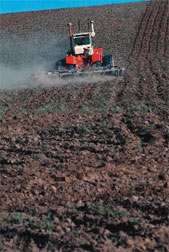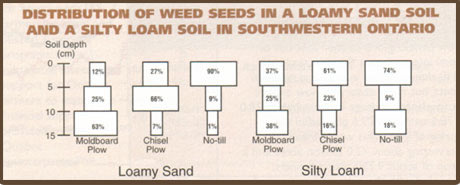Tillage, Soil Type and Weed Seed Bank Dynamics
By Clarence J. Swanton and
Anil Shrestha, Department of Plant Agriculture, University of Guelph
Goals
of integrated weed management (IWM) include increasing knowledge of seed bank
dynamics and exploring how this information can be used by growers to improve
the consistency of their weed control practices. The study of soil weed seed
bank dynamics is a relatively new concept in weed science. The knowledge of
seed bank dynamics can help in the management of weeds in agricultural cropping
systems and in the effective implementation of IWM systems. The weed seed bank
is the main source of weeds in agricultural fields.
 What is a soil weed
seed bank?
What is a soil weed
seed bank?
Soil weed seed banks are reserves of viable seeds present on the surface and
in the soil. The seed bank consists of new seeds recently shed by a weed plant
as well as older seeds that have persisted in the soil for several years. The
seed bank is an indicator of past and present weed populations. There are enormous
numbers of viable weed seeds in the soil. Although a great number of the buried
seeds die within a few years, seeds of some species can remain viable for decades.
It has been estimated that only 1-9% of the viable seeds produced in a given
year develop into seedlings; the rest remain viable and will germinate in subsequent
years depending on the depth of their burial.
How does tillage affect
the weed seed bank?
Tillage affects the vertical distribution of seeds within the soil profile.
Studies so far have shown that the majority of the weed seeds remain at or near
the soil surface in undisturbed soils or in soils where no tillage has been
practiced. Tillage with a moldboard plow buries seeds deeper within the seed
bank. For example, a study in Ontario found that the top 5 cm of soil contained
90% (no-till), 61% (chisel plow), 37% (moldboard plow), and 33% (ridge-till)
of the seeds. Keeping the seeds close to the surface will reduce dormancy, encourage
germination and lead to a more efficient weed management strategy. Thus, adequate
aboveground weed control can diminish the weed seed bank in the upper layer
of soil within a few years in no-till soils. Burying seeds deep within the soil
complicates future weed control efforts.
Is the effect of tillage
on the vertical distribution of the weed seeds similar in all soil types?
It has been established that soil physical properties that influence freezing
and thawing, rates of drying and surface cracking can affect vertical distribution
in the soil. Very few studies, however, have looked at the effect of tillage
systems on the vertical distribution of the seeds in different soil types. Evidence
exists that tillage type has differential effects on seed depth across different
soil types. We present here examples of the vertical distribution of weed seeds
in a loamy sand soil and a silt loam soil in Ontario. Under a moldboard plow
system, 12% of the seeds are present in the top 5 cm of the loamy sand soil
as compared to 37% in the silty loam. Therefore, more seeds may be returned
to the surface in sandy soils than in other soil types when they are inverted
by a moldboard plow. In the sandy soil, the depth of burial of the weed seeds
in the soil profile increased as the depth of tillage increased. In the silty
loam soil, the distribution of the weed seeds in the moldboard system was more
or less uniform in the top 15 cm of the soil profile.
 How can this information
be used?
How can this information
be used?
The effect of tillage on the weed seed banks will vary by soil type. Understanding
the processes that influence the weed seed bank will allow us to manipulate
and manage weed seed banks effectively by implementing more informed weed management
strategies. One strategy is to shift weed seeds from the dormant to the active
part of the seed bank: keeping weed seeds on the soil surface and exposing them
to harsh environmental conditions and predation can enhance the mortality of
the seeds. Weeds can never be eradicated, only managed. The first step towards
improving our weed control practices is to understand how tillage can influence
the positioning of weed seeds in the soil.
Back
to Top


